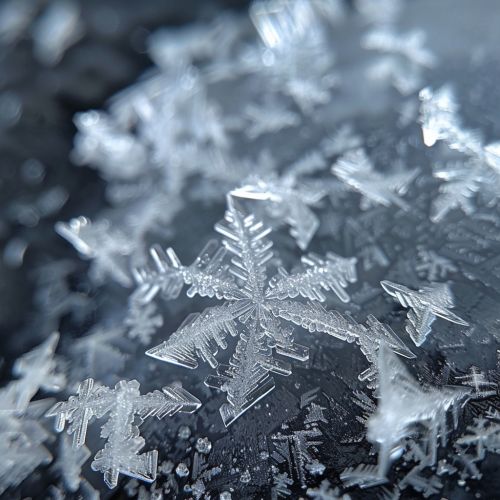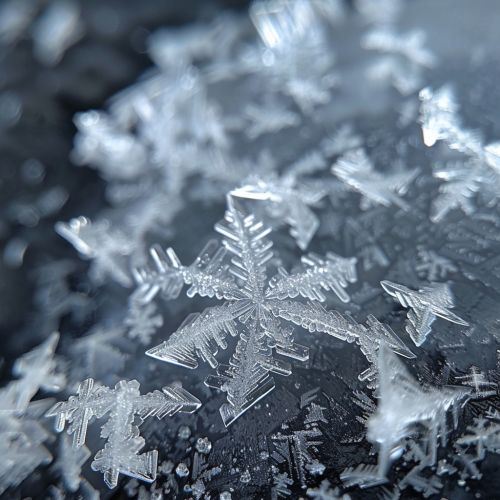Ice-nucleating particle
Introduction
An ice-nucleating particle (INP) is a type of particle that acts as a nucleus for the formation of ice crystals in the atmosphere. These particles play a crucial role in cloud formation, precipitation processes, and the Earth's climate system. Ice-nucleating particles can originate from various natural and anthropogenic sources and have diverse chemical and physical properties.
Sources of Ice-Nucleating Particles
Ice-nucleating particles can be derived from a wide range of sources, both natural and human-made.
Natural Sources
Natural sources of INPs include:
- **Mineral Dust**: Particles from soil and rock erosion, often transported over long distances by wind.
- **Biological Particles**: Bacteria, fungal spores, pollen, and plant debris that can act as efficient ice nuclei.
- **Sea Spray Aerosols**: Particles generated from the ocean surface, including organic matter and salts.
- **Volcanic Ash**: Fine particles ejected during volcanic eruptions that can serve as ice nuclei.
Anthropogenic Sources
Human activities also contribute to the presence of INPs in the atmosphere:
- **Combustion Products**: Soot and ash from industrial processes, vehicle emissions, and biomass burning.
- **Agricultural Activities**: Dust and biological particles released during farming practices.
- **Urban Pollution**: Particulate matter from construction, transportation, and other urban activities.
Mechanisms of Ice Nucleation
Ice nucleation is a complex process that can occur through various mechanisms, depending on the environmental conditions and the properties of the INPs.
Homogeneous Nucleation
Homogeneous nucleation occurs in the absence of any particles, where supercooled water droplets freeze spontaneously. This process requires temperatures below -38°C.
Heterogeneous Nucleation
Heterogeneous nucleation involves the presence of INPs and can occur at higher temperatures than homogeneous nucleation. There are several modes of heterogeneous nucleation:
- **Deposition Nucleation**: Ice forms directly from water vapor on the surface of an INP.
- **Condensation Freezing**: Water vapor condenses onto an INP and subsequently freezes.
- **Immersion Freezing**: An INP immersed in a supercooled water droplet induces freezing.
- **Contact Freezing**: An INP collides with a supercooled water droplet, triggering freezing.
Properties of Ice-Nucleating Particles
The efficiency of an INP in initiating ice nucleation depends on its physical and chemical properties.
Physical Properties
- **Size**: Larger particles generally have a higher probability of acting as ice nuclei.
- **Surface Area**: Increased surface area provides more sites for ice nucleation.
- **Morphology**: The shape and structure of particles can influence their nucleating ability.
Chemical Properties
- **Composition**: The elemental and molecular makeup of INPs can affect their ice-nucleating efficiency.
- **Surface Functional Groups**: Specific chemical groups on the particle surface can enhance or inhibit ice nucleation.
- **Hygroscopicity**: The ability of particles to absorb water can influence their role in ice nucleation.
Environmental Impact
Ice-nucleating particles have significant implications for weather, climate, and the hydrological cycle.
Cloud Formation and Precipitation
INPs are essential for the formation of ice clouds and mixed-phase clouds, which contain both ice crystals and supercooled water droplets. These clouds play a critical role in precipitation processes, including snow and rain formation.
Radiative Forcing
Ice clouds influence the Earth's radiative balance by reflecting incoming solar radiation (albedo effect) and trapping outgoing longwave radiation (greenhouse effect). The presence and properties of INPs can thus affect climate dynamics.
Climate Feedback Mechanisms
Changes in the concentration and composition of INPs can lead to feedback mechanisms that either amplify or mitigate climate change. For example, increased INP concentrations can enhance cloud reflectivity, potentially cooling the Earth's surface.
Measurement and Analysis
The study of INPs involves various techniques to measure their concentration, properties, and effects.
Sampling Methods
- **Aerosol Collectors**: Devices that capture airborne particles for subsequent analysis.
- **Cloud Probes**: Instruments mounted on aircraft to sample cloud particles directly.
- **Ground-Based Observatories**: Facilities equipped with instruments to monitor INP concentrations and properties.
Analytical Techniques
- **Microscopy**: Electron and optical microscopy to examine particle morphology and composition.
- **Spectroscopy**: Techniques such as Raman and infrared spectroscopy to identify chemical constituents.
- **Ice Nucleation Chambers**: Laboratory devices that simulate atmospheric conditions to study ice nucleation processes.
Research and Applications
Ongoing research aims to better understand the role of INPs in the atmosphere and develop applications based on this knowledge.
Climate Modeling
Incorporating accurate representations of INPs in climate models is crucial for predicting future climate scenarios and understanding past climate changes.
Weather Modification
Artificially introducing INPs into the atmosphere, a process known as cloud seeding, can enhance precipitation in drought-prone areas or mitigate hail damage.
Environmental Monitoring
Monitoring INP concentrations and properties can provide insights into air quality, pollution sources, and ecosystem health.
See Also
References


